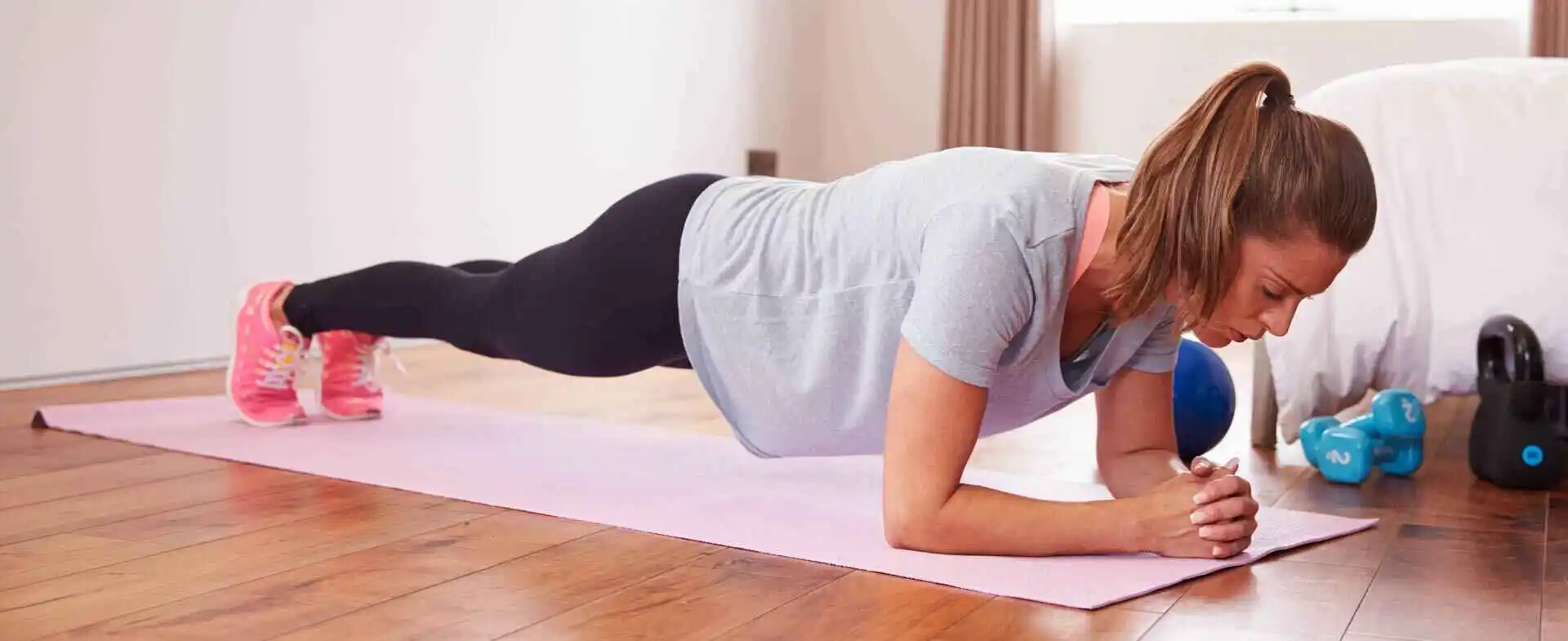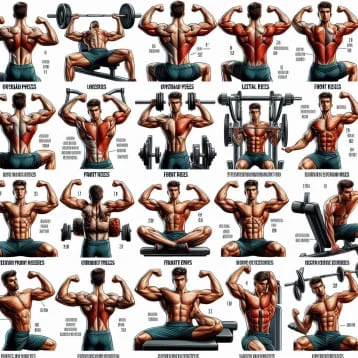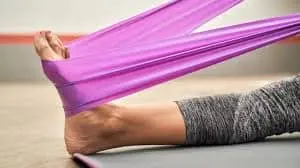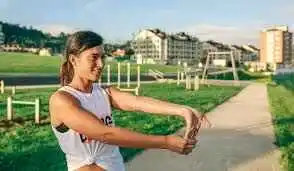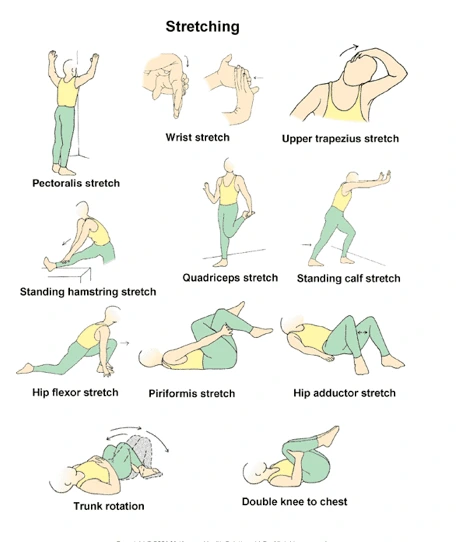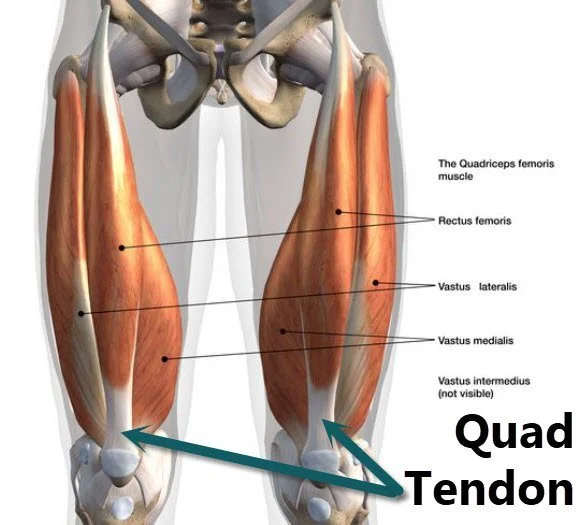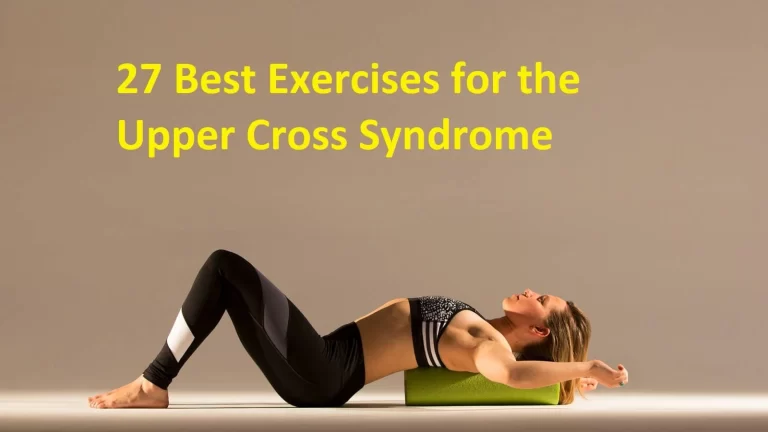27 Best Core Exercises for a Strong and Stable Core
Core exercises are an important part of a thorough workout routine. The muscles in your abdomen, pelvis, and lower back make up your core, and they have an important role in supporting and stabilizing a range of body functions.
You may improve your general balance, posture, and functional fitness by strengthening your core. Planks, crunches, leg raises, and bridges are common exercises for the core.
What are the core muscles?
The upper portion or trunk of the body has a collection of muscles known as the core muscles. To support the spine and maintain proper posture, these muscles are important.
Among the muscles of the core are;
- Internal obliques
These muscles connect the pelvis to the lower ribs horizontally. They help in the trunk’s bending and rotation.
- External obliques
These are the muscles that go the other way to the internal obliques, horizontally from the lower ribs to the pelvis. They support the trunk’s bending and rotation as well.
- Rectus Abdominal
This muscle connects the ribs to the pelvis and covers the length of the anterior abdomen. It is responsible for bending the spine forward and stretching the trunk.
- Transverse abdominis
This deep muscle forms a band of fibers that surrounds the abdomen, much like an elastic waistband. It helps maintain the stability of the spine and pelvis when moving.
On every side of the spine, these muscles run from the pelvis to the head. They support the spine’s natural extension and maintenance of good posture.
- Multifidus
This is a series of tiny muscles extending the spinal column’s length. They help in maintaining proper posture and spine stability.
In general, mobility, stability, balance, and proper posture all depend on having strong core muscles. By stabilizing the spine and relieving pressure on the lower back, they can also help in the prevention of back pain and injury.
The advantages of exercising your core muscles:
Prevention of Injuries
- Injury prevention is among a strong core’s most important advantages.
- These injuries can result from everyday tasks like removing snow, gathering leaves, or reaching into deeper cabinets to locate a pot.
- All kinds of injuries, such as pulled muscles, sprained joints, bulging disks, and even fractured or bruised bones, can be prevented by keeping a strong core.
Improved The effectiveness of Lifting
- The core stabilizes the spine and prevents the disks, muscles, and ligaments from being overstressed when lifting objects.
- Strong core muscles reduce the likelihood of injuries and allow easier item lifting.
Minimizes Back Pain
- Strong core muscles create a structure that supports your spine.
- When performing household duties or other regular movements, back pain can happen if the back support system is not up to the needs of the activity.
- If your core muscles are weak, tasks like vacuuming, washing dishes, mowing the grass, picking leaves, and even gardening can worsen your back pain.
- Any back pain, whether from old injuries, repetitive motions at work, irregular sleep patterns, or even just a terrible night’s sleep, can be significantly avoided or reduced with a strong core.
Sports Performance
- Having a strong core will help you perform at your best if you play any sport you enjoy.
- Athletic exercises that involve the transfer of energy between the upper and lower bodies via the core include running, jumping, kicking, and dancing. Consider kickboxing as an example.
- When you punch, most of the force should come from your lower body.
- When your core muscles are strong, you can move energy from your bottom body to your upper body properly.
Better Stability and Balance
- In daily life, it is important to have excellent stability and balance.
- Your balance and stability will be put to the test when putting on clothes, walking in freezing water, and performing other tasks requiring careful footwork.
- If your core muscles are strong, you can avoid getting hurt when you slip and fall and face challenges in life with support and stability.
Exercise for the core muscles:
Bird Dog
The bird dog strengthens your back and abdominal muscles, making it an excellent core exercise. It also examines your stability, balance, and coordination.
- Start by putting yourself in a tabletop position and relaxing on all fours.
- Now place your knees below your hips and your hands under your shoulders.
- Keep your spine in an upright position.
- Now squeeze your shoulder blades.
- Then reach up toward the highest point with your right arm and left leg.
- Keep your shoulders and hips in a straight line position.
- Hold this position for a few seconds.
- Then return to your neutral position.
- Then relax.
- Do five or ten repetitions of this exercise.
- Repeat the exercise on the opposite side of your body.
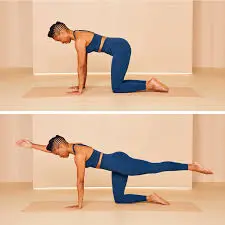
Bridges
By activating your glutes to raise your hips, this position tones your thighs and butt while also strengthening your core.
- To start, take a comfortable position on the surface of the mattress.
- With your feet flat on the mattress, bend your knees at this moment.
- Next, contract your abdominal muscles.
- Raise your upper body.
- Kindly keep your arms at your sides.
- Hold this position for a few seconds.
- Lower your body.
- Then return to your neutral position.
- Then relax.
- Do five or ten repetitions of this exercise.
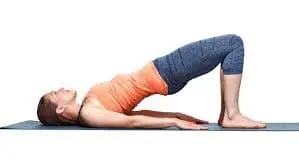
Supine toe tap
This is an essential Pilates exercise routine. It tones your hips, glutes, and legs while strengthening your core. You can also slightly compress your spine with toe taps.
- Start by lying down on your back.
- Raise your thighs and make a 90-degree bend in your knees.
- Your hands should be by your sides.
- The palms need to be down.
- You have to contract your core muscles.
- Step down with your right foot and tap the ground gently.
- Keep your left leg fixed while maintaining your back flat.
- To get back to where you were before, lift your right leg.
- Then relax.
- Do five or ten repetitions of this exercise.
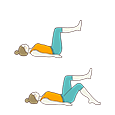
Crunch
Crunches are a classic way to strengthen your core. As you move your upper body, you strengthen your core muscles. If you experience frequent lower back pain, start with a small number of crunches and continue gradually.
- Start by lying down on your back.
- Bend your knees and place both your feet with your hips wide on the ground.
- Your spine and head should be straight.
- Put your arms behind your head.
- Your shoulder and neck muscles should be relaxed, and your core muscles should be tight.
- Raise your upper back and pull your chin in while keeping your feet, pelvis, and lower back on the floor.
- Hold this position for a few seconds.
- Then return to your neutral position.
- Then relax.
- Do five or ten repetitions of this exercise.
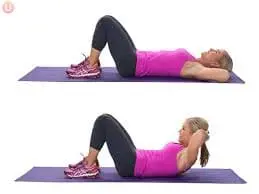
Leg Lowers
This is a great core exercise that targets your hips and rectus abdominus, or six-pack.
This exercise may also help you gain more hip flexibility because it requires you to keep your legs straight when lowering and raising them.
- Laying on your back with your arms at your sides and your legs extended is a good starting position.
- One leg should be straight and pointing toward the highest point.
- Keeping your lower back flat on the ground and using your lower abs, gradually lower that leg toward the ground.
- Then return to your neutral position.
- Then relax.
- Do five or ten repetitions of this exercise.
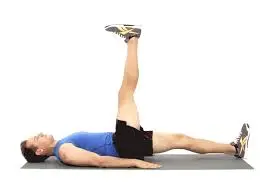
Squat To Oblique Twist
This exercise is great for your core because it improves your quads, glutes, and core muscles. A squat works your lower body, and a knee use, which improves stability and balance, works your hip flexors and obliques. Then, by testing the coordinated action of your obliques and core muscles, the twisting motion strengthens your core overall.
- Starting from a standing position, place your hands slightly behind your ears and place your feet shoulder-width apart.
- It’s essential to keep your chest high and distribute your weight evenly between your heels and toes when lowering your body into a squat.
- Push through your feet to get back up on your feet.
- After that, turn your body, lift one leg over your chest, and bring the opposite of the individual’s elbow up to your knee.
- Lower your knee back to the beginning position.
- Then relax.
- Do five or ten repetitions of this exercise.
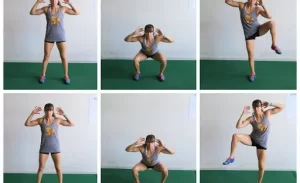
Incline Mountain Climbers
This is a great workout to develop your core since it targets your obliques and abdomen, which help stabilize your body while you move your legs.
If you do not have availability to a bench or chair, you may instead practice this exercise against a wall to further target your stomach and hips.
- Start in a high plank posture, placing your hands on a wall, bench, step, or chair.
- Raise one knee to your chest and then progressively lower it back down.
- At the top of the movement, concentrate on control and keep your lower back stable.
- Then return to your neutral position.
- Then relax.
- Do five or ten repetitions of this exercise.
- Repeat on the other leg, making sure your core stays engaged the entire time.
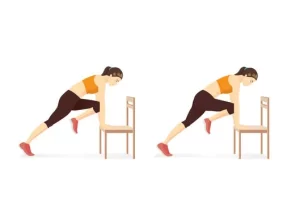
Bicycle crunch
This version of the standard crunch targets your hip, rectus abdominous, and obliques muscles.
- Start by laying on your back on the ground with your left leg bent and pulled toward your chest.
- Keep your right leg straight and just slightly raised off the floor.
- Place your hands behind your head or on the top of your neck.
- When doing this exercise, take care not to strain your neck.
- Your left knee has to be bent, and your right leg should be straight.
- With your elbow pointing in the direction of your left knee, raise your right shoulder off the ground.
- Extend your left leg toward your chest while bending your right knee as you pull your right shoulder back to the floor.
- Raise your left shoulder off the floor and shift your left elbow toward your right knee as your right knee goes further.
- Then return to your neutral position.
- Then relax.
- Do five or ten repetitions of this exercise.
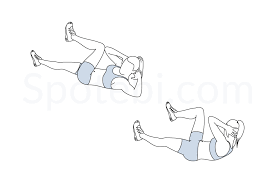
Plank
It also helps in strengthening the muscles in your legs, glutes, back, shoulders, and arms.
- Starting from a position on all fours, place your hands below your shoulders and your knees under your hips.
- Straighten your legs behind you while keeping your feet hip-width apart.
- Maintaining a strong core.
- To create a straight line throughout your neck, spine, and glutes, lift your body.
- Hold this position for a few seconds.
- Then return to your neutral position.
- Then relax.
- Do five or ten repetitions of this exercise.
- Keep your entire weight over your hands and your knees on the ground to make this exercise simpler. Pose yourself straight from your legs to your shoulders.
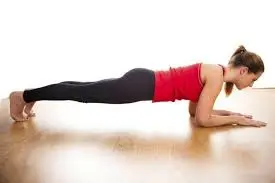
Bird dog with elbow-to-knee
Using its smooth movements, this variation on the traditional bird dog strengthens your core and tones your back and abs.
- Starting on all fours, place your hands under your shoulders and your knees below your hips.
- You have to tighten your core muscles.
- Lift and extend your right leg to the height of your hips.
- Raise and extend your left arm to shoulder level similarly.
- The palm should be down.
- Straighten your right knee and bend your left elbow.
- Then return to your neutral position.
- Then relax.
- Do five or ten repetitions of this exercise.
Russian Twist
This exercise targets your obliques, which are normally overlooked in traditional ab exercises, as well as your rectus abdominis, or the muscles we typically connect with a six-pack. This works at your core.
- Beginning with your feet flat on the ground and your knees bent, lie down on the ground.
- Adjust your feet a few inches above the ground while bending slightly back and maintaining your sit bones.
- Turn your body to one side while holding a weight in front of your chest.
- Put the weight on the floor next to your hip before switching to the other side.
- Then return to your neutral position.
- Then relax.
- Do five or ten repetitions of this exercise.
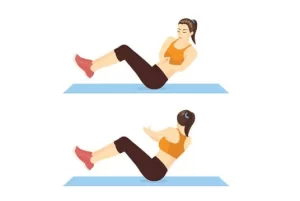
Kettlebell Goblet Squat
This exercise is important for developing your core since it puts more pressure on your core to maintain stability and balance while you lift weight in front of your chest. It tones your lower body as well.
- Hold a kettlebell in front of you with your feet a bit wider than hip-width apart and your toes pointed a little outward.
- With the head facing up, grip the kettlebell with the weight slightly below your chin and press your elbows into your chest.
- As you bend your hips and knees, contract your core and keep your arms close to your chest with your elbows directed downward.
- As low as possible, squat.
- Hold this position for a few seconds.
- After that, use your heels, legs, and glutes to push yourself back up to the initial position.
- Then relax.
- Do five or ten repetitions of this exercise.
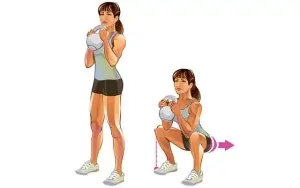
Stability Ball Stir The Pot
While rotating and maintaining a plank stance with your forearms, stirring the pot on a stability ball tests your abdominal stability and strengthens your core muscles.
- Starting with your forearms resting on a stability ball, extend your legs straight back behind you to form a high plank position.
- It must be done for your body to form a straight line from your head to your heels.
- For the stability ball to follow you while your body stays still, contract your abdominal muscles and rotate your forearms in a full circle.
- Then return to your neutral position.
- Then relax.
- Do five or ten repetitions of this exercise.
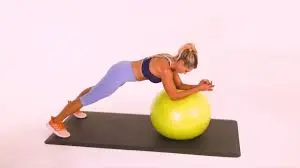
Dead Bug
Targeting the rectus abdominis, transverse abdominis, and hip flexors, the dead bug exercise is a well-known core workout.
- Start by extending your arms towards the ceiling and achieving a tabletop position with your legs.
- To start, bend your knees to a 90-degree angle and arrange them over your hips.
- While lowering your left arm overhead, slowly extend your right leg straight.
- Keep both at a few inches above the floor.
- For the duration of the workout, keep your core active and compress your glutes.
- Put your lower back down on the floor.
- Then return to your neutral position.
- Then relax.
- Do five or ten repetitions of this exercise.
- Use your left leg and right arm, and repeat the movement on the opposite side.
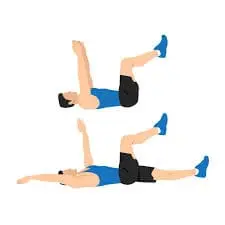
Stability Ball Dead bug
Adding a stability ball to your dead bug is a great way to work your abs while also strengthening your core.
- Begin by lying on your back with your arms extended over your chest and your legs bent 90 degrees.
- keep a stability ball within your knees and forearms.
- Press your lower back into the mat while contracting your core.
- Then, slowly and at the same time stretch your right leg and lower it to your heel almost touching the floor.
- Reach your left arm upward till your hand almost touches the ground behind you.
- Then return to your neutral position.
- Then relax.
- Do five or ten repetitions of this exercise.

Glute Bridge March
A fantastic exercise for building strength in the core, glutes, and hip flexors is the glute bridge march.
- To begin, lie on your back with your feet flat on the floor, your heels under your knees, and your legs bent.
- Indeed, raise your arms over your chest with your palms pointing down.
- Lift your hips to create a straight line in your body from your shoulders to your knees.
- Raise your right knee over your hip while keeping your right leg at a 90-degree angle while maintaining your abdominals stable.
- Hold it for just a second before lowering your right foot.
- Then return to your neutral position.
- Then relax.
- Do five or ten repetitions of this exercise.
- Repeat with the left hand.

Inchworm
This full-body, bodyweight exercise develops flexibility while working the arms, upper back, legs, and core.
- Start by placing your feet hip-width apart.
- Observe your posture.
- Your hips, knees, ankles, and ears should all line up with your engaged abdominal muscles.
- Breathe in, then as you release, eyes down at the floor in front of your feet and start reaching with your hands.
- Your back will flex forward as a result, allowing each vertebra to slide out one at a time.
- If required, flex your knees just enough to allow your hands to make contact with the floor.
- Place your hands in front of your planted feet.
- Breathe in and move each hand forward one at a time.
- As your body starts to straighten, let your heels come off the ground.
- When your hands are slightly behind your shoulders, check the positioning of them.
- You should be in a full plank posture, with your body making a straight line from your heels to your head and your core, chest, quadriceps, and triceps engaged.
- Step one foot at a time forward toward your hands while maintaining an almost straight posture.
- As your legs start to rise toward the ceiling, this should give your hamstrings, calves, and glutes a great stretch.
- Take a breath and move forward.
- When your feet are as close as they can easily be to your hands, stop.
- To reduce the pressure on your hamstrings, keep in mind that you can slightly flex your knees, but you need to try to keep them as straight as possible.
- To stand up again, gradually move your back up from your hips, straightening your spine one at a time.
- Breathe in as you move.
- You’ve finished one repetition when you’re back where you started.
- Then relax.
- Do five or ten repetitions of this exercise.

V-Sit Pose
This wonderful abdominal workout, the V-sit, targets the external, internal, and rectus abdominis. It works on the hip flexors as well.
- While seated on a mat, contract your abs and gently lean a few degrees.
- Raise your legs slowly into the air such that they resemble a table.
- Make sure your arms are parallel to the mat by reaching them straight out in front of you.
- Create a “V” with your body by extending your legs straight up to a 45-degree angle while maintaining an engaged core.
- Try raising your arms toward the ceiling to see if you feel balanced at this point.
- There’s always the choice to turn them away from you directly.
- Maintain a comfortable position on tight abs and a squeezed-in inner thigh.
- Hold this position for a few seconds.
- Lower your arms and legs to the starting point posture.
- Then relax.
- Do five or ten repetitions of this exercise.
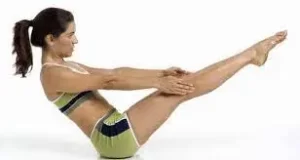
Single-Arm Floor Press Deadbug
Your balance and stability will be put to the test more because you are pressing with just one arm, which forces your body and core to fight the urge to twist as well as engage your core.
- Starting from a lying down position, raise your arms to your chest and bend your legs so that your knees are over your hips.
- With the palm of your left hand facing away from you, hold a dumbbell.
- Put some force into your lower back by using your core.
- That’s where you start.
- As you carefully extend and lower your right leg until your heel nearly touches the ground, bend your left arm to form a 45-degree angle with the floor.
- Hold this position for a few seconds.
- Then return to your neutral position.
- Then relax.
- Do five or ten repetitions of this exercise.
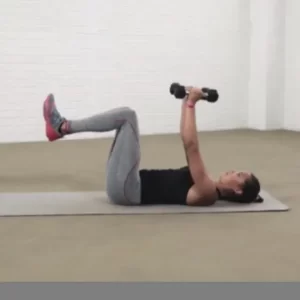
Kettlebell Bridge Pullover
Due to its dynamic nature, this exercise provides a lot of time under pressure while also strengthening the anterior core and glute muscles.
- Start by lying firmly on your back with your feet flat on the ground and your knees flexed.
- Holding a kettlebell with both hands, place it above your chest.
- Raise your hips so that your body makes a parallel path from your shoulders to your knees.
- Lift the kettlebell and place it across your chest.
- Next, without creating an arch in your back or spreading your ribs, progressively lower it such that it almost reaches the floor on the back side of you.
- Bring the kettlebell back over your chest by using your core.
- Then return to your neutral position.
- Then relax.
- Do five or ten repetitions of this exercise.
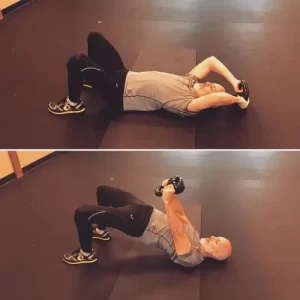
The warrior crunch
This type of crunch works your quadriceps, thighs, and glutes along with your core.
- Your toes should be pointed outward when you stand with your feet a bit wider than shoulder width.
- Reach back behind your head and spread your arms wide.
- The core and glutes should be tight.
- Lift your thighs off the ground by bending your knees.
- Lift your right elbow toward your right leg as you flex your torso to the side.
- Then return to your neutral position.
- Then relax.
- Do five or ten repetitions of this exercise.
- Continue with the left side.
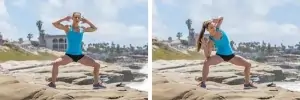
Side plank
By engaging the muscles on the side of your body, the side plank tests your stability and strengthens your core.
- Take a lateral posture, lifting your left arm onto your forearm.
- Keeping your hips, knees, and shoulders in a straight line, place your left shoulder exactly over your left elbow.
- Your right arm should be rested against your side.
- Squeeze in your abdominal muscles.
- Hold this posture for a few seconds.
- Then return to your neutral position.
- Then relax.
- Do five or ten repetitions of this exercise.
- Repeat with your side to the right.
- Try balancing with your left hand for extra difficulty.
- Lift your hips off the ground and lift your right hand toward the sky

Butterfly Sit-Up
- Your legs should be bent out to the sides while you lie face-up with your feet touching.
- Lift your arms above your head.
- This is where we are beginning.
- To sit up straight, use your core to roll your body up.
- Touch your toes with your extended reach.
- Then return to your neutral position.
- Then relax.
- Do five or ten repetitions of this exercise.
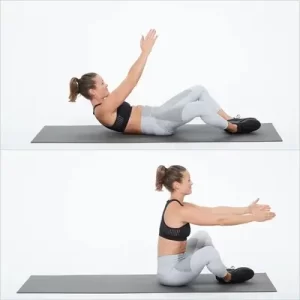
Staggered Stance Resistance Band Row
- To create a staggered stance, place your left foot in front of your right.
- To make it easier for yourself into this position, take a wider stance.
- Maintain a grip on one end of the resistance band in each hand while looping it under your left foot.
- To ensure that your back is straight and your core is active, slightly bend your left knee and turn forward at the hip.
- The band should be flexible when you reach fully down towards your left foot with your arms.
- It is where you are in the beginning.
- Perform a row while keeping your elbows, forearms, and hands parallel to your chest and pushing your hands toward the center of your body.
- To finish the repetition, extend your arms back to your starting position.
- Then relax.
- Do five or ten repetitions of this exercise.

Flutter Kicks
Flutter kicks are another perfectly simple move that will significantly improve core strength.
You can strengthen your core stabilizing compounds while maintaining a lower back-safe posture by extending your legs and lifting your heels.
- For lower back support, lie on your back with your arms by your sides or under your hips.
- bring your belly button in toward your spine.
- Keeping your chin pulled in, raise your head, neck, and shoulders off the mat if you can, pressing your lower back into the surface.
- If it’s more comfortable, you can also maintain your upper body on the ground.
- Elevate your legs a little off the ground, then scissor-kick them up and down in a limited range of motion.
- Then return to your neutral position.
- Then relax.
- Do five or ten repetitions of this exercise.
Bear Crawl
Your core muscles must work extremely hard as you crawl on all fours and hang over the ground during this exercise because your spine, hips, and shoulders must remain balanced. Bear crawls are great warm-up or cool-down exercises because they work your entire body.
- Take a push-up to begin the bear crawl.
- Your back is strong, your hands are under your shoulders, and your core is active.
- The heels of both feet should be off the ground and hip-distance apart.
- Crawl forward by moving your left leg and right hand in rhythm.
- You never come into contact with the floor with your knees.
- Immediately after putting weight on the right hand and left leg, switch sides, pushing the right leg and left hand forward.
- Keep going to move forward for the number of steps or distance you have decided upon, still crawling.
- Then return to your neutral position.
- Then relax.
- Do five or ten repetitions of this exercise.
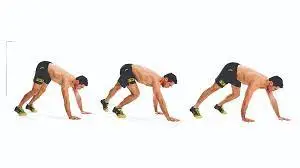
Turkish Get-Up
- With your legs folded over one another and your knees bent, take a lying position on the floor on your right side.
- With your elbows bent and both hands holding the kettlebell squarely in front of your chest, your left hand covering your right hand while your right grips the handle.
- As you turn over onto your back, raise the kettlebell to your chest.
- Stretch both arms out and press the kettlebell upwards into the air.
- keep out your right elbow, bring your right arm parallel to the floor, and pull your right shoulder into the correct position.
- After the kettlebell has stabilized and secured into place, flex your left arm and leg out to the side, about 45 degrees from your midline.
- With your right foot firmly planted on the floor close to your glutes, your right knee should stay bent
- Inhale deeply, then roll to the left, pressing up onto your left elbow, using your right heel as support.
- After releasing your breath, exhale and raise your entire body onto your left palm to take on a seated position.
- At this point, fully extend your left arm.
- Keep your elbow locked into the shoulder socket, your arm supporting the kettlebell fully extended, and the kettlebell consistently parallel to the floor as you sit upright.
- In other words, your arm shifts from being extended over your chest to being directly over your shoulder as you sit down.
- Lift your thighs as high as you can while squeezing your glutes as if you were doing a bridge exercise
- Inhale before beginning the hip extension, then release the breath as you raise your hips.
- Maintain a straight extension of the kettlebell over your shoulder, parallel to the ground.
- Your right foot, left arm, and the outside of your left foot should all be supporting your extended hips.
- Put your knee and ankle on the ground in a modified kneeling position as you move or draw your left leg (the extended one) under your body, bending it and landing it behind and in line with your left hand.
- The kettlebell should stay parallel to the ground as you complete this leg sweep, which means your right hip and shoulder will rotate upward toward the ceiling and the arm holding the kettlebell will likewise shift into an adducted position from your midline to form a 90-degree angle with your body.
- Breathe in deeply, ensuring your core is working, and then exhale.
- Taking your left hand off the floor, raise your body to an upright position, and you should be kneeling or pushing.
- To align your legs squarely, let your left foot move naturally in that direction.
- Once you’re kneeling, maintain the kettlebell parallel to the ground.
- This will require you to straighten your arm from your shoulder and position it in an overhead press.
- After you’re positioned, move your eyes to look directly ahead.
- Step your back foot forward to come to a standing position by fully extending your knees and hips.
- Squeeze through your back foot and front heel and engage your core to pull yourself up.
- Keep your eyes focused forward.
- Breathe out as you stand. Your feet should be about hip-distance apart when standing.
- After completing half of the getup, you must reverse the movements to get back to the ground.
- With your left foot planted firmly on the ground, take a step backward.
- With both knees bent and your back knee lowered gradually toward the floor, maintain your eyes forward, your core active, and your right arm fully extended over your shoulder.
- As soon as your knee touches the floor, plant your left toe so that the top of your foot is level with the surface.
- To make your left leg and knee parallel to your right knee, rotate them by about ninety degrees.
- With the kettlebell still parallel to the floor, engage your core and tip it gently from the hip so that your left hand is on the floor in front of your left knee.
- When you perform this exercise, keep your eyes fixed on the kettlebell.
- Extend your leg so that your right foot, the outside of your left foot, and your left hand support you in a tripod position as you move your left leg back under your body while maintaining an elevated hip and contracted abs.
- As you perform the exercise, make sure you maintain your attention on the kettlebell and that it remains parallel to the floor.
- Take a seated position by lowering your hips to the floor.
- Rotate until you land on your left elbow.
- After that, carefully roll to the floor so that you are lying down and the kettlebell is still opposite to the floor but in the chest press position.
- After helping with the kettlebell return to your chest with your left hand, bend both of your knees, and roll to your left side into a lying down position.
- You have finished one complete repetition to the right.
- Then return to your neutral position.
- Then relax.
- Do five or ten repetitions of this exercise.
- Repeat the exercise on the left side.
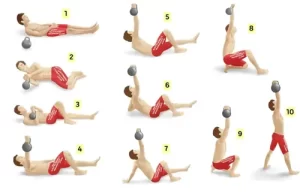
How can yoga improve the strength of my core?
- Yoga offers many more health benefits besides just strengthening your core.
- It can support improved posture, strength, weight loss, and injury prevention.
- To support the weight of other body parts during the various movements, yoga works by strengthening the core through the way the exercises activate the muscles.
- Yoga uses your core continually to resist gravity and your body weight, making it a great type of training.
- The transversus abdominis and internal obliques are two deeper muscles that help strengthen the core. Yoga helps target these muscles.
Which safety precautions need to be followed while you’re working out?
Exercise should be done correctly and safely, taking into consideration the particulars of your situation.
- Stretch and warm up before working out.
- Maintain proper posture during the exercise.
- Stay away from hard workouts.
- If exercising is uncomfortable for you, stop.
- In between sets of exercises, rest.
- Stay hydrated.
- Dress comfortably so that your body may move freely during the exercise session and stay away from wearing tight clothing.
- It is never a good idea to hold your breath when working out.
- It’s recommended that you take deep breaths and exhale them gradually through your mouth when exercising.
- Holding your breath while exercising causes your muscles to stiffen up more, which raises your risk of high blood pressure.
At what moments do you not work out?
- A burning sensation in the muscles
- You don’t feel good.
- If any pain or numbness is experienced.
- Fever
- Headache
- Stop working out if it aches and pains.
Summary:
Core-strengthening exercises are an excellent way to start, whether you’ve decided to start exercising or just add some extra intensity to your current routine.
Visit your doctor for advice before starting a new fitness program. If you can, get advice from a physical therapist about how to safely tone and train your core, especially if you have a history of back injuries.
FAQ:
Core exercises: what are they?
Exercises for the core focus on the back, pelvic, and abdomen muscles, which support and stabilize the spine.
Should I perform core exercises if I’m injured in my back?
If you have a back problem, it’s essential to get in touch with your doctor before beginning any fitness program. They can provide you with advice on the safest and best workouts for your particular situation.
If my core is weak, can I still perform core exercises?
Yes, you can use core workouts to strengthen your weak abdominal, back, and pelvic muscles. As your strength grows, it’s important to gradually move up to a more difficult routine. Start with basic ones.
How can I strengthen and stabilize my core better?
Plank
Bicycle crunch
Russian Twist
Glute Bridge March
Butterfly Sit-Up
Supine toe tap
Why is there poor core stability?
Your core muscles can only work as intended when your body is properly positioned or aligned. If not, a vicious cycle may start in which your core muscles lose their capacity to work as a result of bad posture coupled with weakness from injury or lack of exercise.
Can you perform daily core exercises?
To allow your muscles to rest and recover, it is advised that you take at least one day off between abs exercises. recommends doing two to three 5-to 10-minute sessions of core work per week.
What five elements makeup core stability?
The five elements of core stability strength, endurance, flexibility, motor control, and function are dealt with in core stability protocols, which are therapeutic stretches and exercises.
Does doing core exercises make you stronger?
Core-building exercises help to build stronger muscles. Core muscles are those found in your back, abdominal, and pelvic area. Strong core muscles make a variety of physical tasks easier to complete.
Does having a strong core improve posture?
These deep muscles in your back, pelvis, and abdomen are known as core stability muscles or postural muscles. They hold you together like a structure or waist. Maintaining correct posture requires having strong core muscles.
What is a deep core exercise practice?
Your whole core, which includes your deep core, is made up of your rectus abdominis in the front of your body, your glutes, and your obliques on the sides of your body. Exercises like planks and renegade rows that require stability and anti-rotation will activate these muscles.
References
- MIRROR (n.d.) presents six advantages of having a strong core in daily life. advantages-strong-core: https://mirror.co/reflections/posts
- K. Nunez (2023, Mar. 16). Which Core Exercises Are Best for Every Fitness Level? We line. The best core exercises, according to Healthline, are for beginners.
- September 21, 2022, Ms. E. Q. 20-Minute Cardio Exercise. well-fitting. Quick Core Workout Routine (3120075) – https://www.verywellfit.com
- On June 2, 2023, CPT, A. M. W., RYT, E. M. C., CPT, J. M., and CPT, C. S. Top Trainers Recommend 34 Core Exercises to Target Every Aspect of Your Abs. SELF. Top trainers swear by these core exercises: https://www.self.com/gallery/
- Breitowich, A., and E. Shiffer (2023, October 9). For Firmer, More Sculpted Abs, Try These 20 Intense Core Exercises Instead of Crunches. The Health of Women. Core workout routine: https://www.womenshealthmag.com/fitness/a20702505
- Image 3, Supine Toe Taps Flow Yoga | Tummee.com – Yoga Sequences, Advantages, Combinations, and Sanskrit Pronunciation. October 14, 2018. Tummee.net. supine toe taps flow on https://www.tummee.com/yoga-poses
- Image 5, Allow Us to Discuss Leg Lowering. August 20, 2015. “Let’s talk about leg lowering,” by Harold Gibbons | MovementGPS, August 20, 2015.
- Image 6, Web Store: 18573393 (n.d.). The product detail page for Salecinask is 18573393. html.
- Image 7, Exercises, routines, and regimens related to mountain climbing on benches. (No date). Exercises: Mountain Climber on Bench at https://www.workoutsprograms.com
- Image 8, D. on June 3, 2021. Exercise Guide with Illustrations: Bicycle Crunches. Cycling crunches using SPOTEBI. https://www.spotebi.com/exercise-guide/
- Image 10, To view, sign up, or log in. (As of now). /photos/a.2100717493492551/2474760476088249/?type=3 https://www.facebook.com/2100695883494712
- Image 11, Russian Twist with Weight. (2019, June 13). The Health of Women. Weighted Russian Twist 0: https://www.womenshealthmag.com/fitness/a20701723
- Image 12, E. Splatt (2017) 1 August. Discover the Correct Way to Perform the KB Goblet Squat – PD4PTS. PD4PTS. https://www.pd4pts.com.au/2017/06/26/learn-kb-goblet-squat-correctly/
- Image 13, A. Dehnke (2021) March 29. Mix-the-Ball Stability-Oxygen Mag. Stability Ball Stirs the Pot: https://www.oxygenmag.com/video/
- Image 15, ball workout for exercise – Sepcleat (n.d.). https://www.sepcleat.com/search/exercise-ball-workout?selp=spyOyU3dXonYnLnJ4RfxFChy4a5DtgBlzqfhwAV22geDIavR-N7v6on1fUdBOOyUEUJIp4arcQkfamM6F6WXj-lUOzP.
- Image 18, August 10, 2021; Ms. E. Q. How to Perform a V-Sit. well-fitting. This is the V-Sit-AB Exercise (3120059) on VeryWellFit.com.
- Image 19, March 20, 2020, F. F. Chest Press for Single Arm Dead Bug. YouTube. YouTube: https://www.youtube.com/watch?v=Sw63gzxFSH8
- Image 20, A. M. Practice (2020, April 13). Pinterest. https://in.pinterest.com/pin/713750240933707581/Glutes
- Image 21, Core Workout at Summer Boot Camp. (June 24, 2014). The summer boot camp core workout can be found at https://www.acefitness.org/resources/pros/expert-articles/4919.
- Image 23, Skimble.com. Butterfly Sit-ups, n.d. How to do Butterfly Sit-Ups: https://www.skimble.com/exercises/70657
- Image 24, Resistance Band Row in Staggered Stance. (n.d.). skimble.com. This exercise can be performed in a staggered stance, or resistance band row, and is part of the Skumble Fitness program.
- Image 25, Sepcleat, “flutter kicks,” n.d. The following link: https://www.sepcleat.com/search/flutter-kicks?selp=spyOyU3dXonYjmnVpSNQl89D-ibCU-xFzsmM15V9VDnc5UYK1_bcsY9jVuwEssmfxmVNZ5Z-mbU-0nmo3CTd
- Image 26, February 14, 2024: Cpt, C. F. Get Healthy U.S. – How to Perform a Bear Crawl. Chris Freytag | Get Healthy U. Bear crawl exercise: https://gethealthyu.com/
- Image 27, K. and K. (2012, 25 April). The Greatest Kettlebell Exercise: The Turkish Getup. The Greatest Kettlebell Workout | Kettlebell Fans’ Guide. The Turkish Getup is available at https://www.bestkettlebellworkout.com/.

